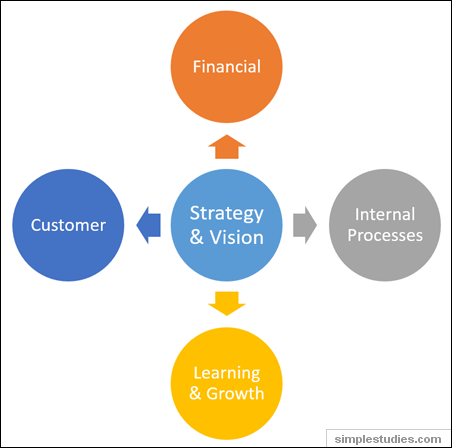Briefly about balanced scorecards
Balanced scorecards have a long history in helping organizations become better at what they do. We have a brief review of balanced scorecards in this article.
1. What is a balanced scorecard?
A balanced scorecard is a management tool used to implement strategic goals and to evaluate and improve performance of an organization.
Balanced scorecards were introduced back in 1980s and have since been successfully used by thousands of companies. These scorecards are balanced because they incorporate a set of four perspective, which represent different aspects that impact the success of an organization. These perspectives are financial and non-financial in nature:

A balanced scorecard begins with the organizational strategy and vision. Management uses strategy and vision as the guide of the organization’s direction, which impacts the other perspectives of the scorecard. Once strategy and vision have been determined, the organization creates a set of key performance indicators (or measures) for major initiatives in light of the following four perspectives:
- Financial: as the name implies, these measures relate to the financial performance of an organization. Examples can be gross margin percentage, revenue growth, and net profit.
- Internal processes: these measures show how efficient organizational processes are and may include lead time to new products or defect rates.
- Learning and growth: these measures represent organizational capacity to learn and grow and a lot of measures in this area relate to the most important asset of an organization, its people.
- Customer: measures in this area address customers (or stakeholders in general) of an organization and may include customer satisfaction scores, new customer growth, or customer retention.
Each key performance indicator in the balanced scorecard is tied to a specific organizational goal (or goals) from the organization’s strategy and vision map. Each indicator (measure) is calculated periodically and compared to a pre-determined target to assess whether the organization is achieving its strategic goals. Finally, appropriate action (tactical) steps are taken to help achieve targets for measures included in the balanced scorecard.
It is important to note that there are multiple variations of balanced scorecards as they are improved by organizations and management professionals over time. For example, some organizations include “Sustainability” as the fifth perspective in their balanced scorecards or include sustainability measures within the traditional four perspectives.
Finally, accountants and financial professionals may play a significant role in defining and moving forward balanced scorecards in their organization. These professionals have significant amount of data on their hands (in financial systems) and data-driven mindset to help with successful balanced scorecard rollouts.
